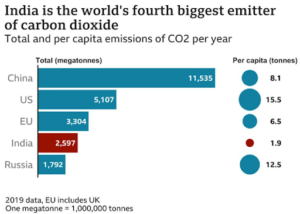In news– During the COP26, the Indian Prime Minister launched Infrastructure for Resilient Island States (IRIS) to secure and strengthen critical infrastructure in small island states against disasters induced by climate change.
New pledge-
- The Prime Minister promised to cut its emissions to net zero by 2070 – missing a key goal of the COP26 summit for countries to commit to reach that target by 2050.
- China has announced plans for carbon neutrality by 2060, while the US and EU aim to hit net zero by 2050.
- India was the largest emitter, and the only G20 country, not to have announced a net-zero target until now.
- It is the first time that India has set a net zero target, at the Glasgow summit.
- He also announced that India would make a one billion-tonne reduction in projected emissions from now until 2030.
Five big announcements-
Making five big-ticket announcements at the climate change meeting in Glasgow, PM has called it ‘Panchamrit’.
- The Prime Minister significantly increased India’s previous climate targets, mentioned in the promises made during the Paris Agreement.
- India’s target for installed renewable energy capacity by 2030 has been enhanced from 450 GW to 500 GW.
- At the same time, the share of renewable energy in India’s total electricity generation has been increased to 50 per cent by 2030 instead of 40 per cent earlier.
- India’s emissions intensity, or emissions per unit GDP, will be reduced by at least 45 per cent by the year 2030 from the 2005 levels. (In its existing target, India had promised to reduce its emissions intensity by 33 to 35 per cent by that date).
- India is currently the fourth largest emitter of greenhouse gases, releasing over 3 billion tonne every year. India’s emissions are rising, at about 4 to 5 percent every year. It is in this amount that a one billion tonne reduction has been announced.

Infrastructure for Resilient Island States or IRIS-
- IRIS is the first major initiative by the Coalition for Disaster Resilient Infrastructure (CDRI) started by India in 2019.
- It seeks to operationalize the CDRI initiative.
- Several small island states have joined the IRIS platform, and drawn up plans for implementation.
- Its work involves mobilizing and directing financial resources towards building resilient infrastructure, retrofitting existing infrastructure, development of early warning systems, and development and sharing of best practices.
- It will be implemented between 2022 to 2030 in 58 countries located across three geographic regions: the Caribbean, the Pacific, and the Atlantic, Indian Ocean, Mediterranean and South China Sea.
About Coalition for Disaster Resilient Infrastructure (CDRI)
- CDRI is the effort to climate-proof critical infrastructure in member countries.
- It was launched by the Indian Prime minister at the UN Climate Action Summit in New York in 2019.
- Twenty-six countries, including the US, Germany, UK, Australia, Brazil, Bangladesh, Afghanistan, Nepal, Bhutan, Sri Lanka, and Japan are already part of the coalition.
- The aim of CDRI is to minimize the damage and disruptions.
- It is also aimed towards achieving the adaptation goal.
- The coalition will not create any new infrastructure — rather, it will serve as a ‘knowledge centre’ for member countries to share and learn best practices with respect to disaster-proofing of infra.
- It will work towards making existing and upcoming infrastructure in member countries more robust and resilient against climate disasters such as floods, heat, cyclones, forest fires, and rain.
CDRI is India’s second international climate initiative; the first was the International Solar Alliance (ISA), launched at the 2015 Paris climate change conference.
















